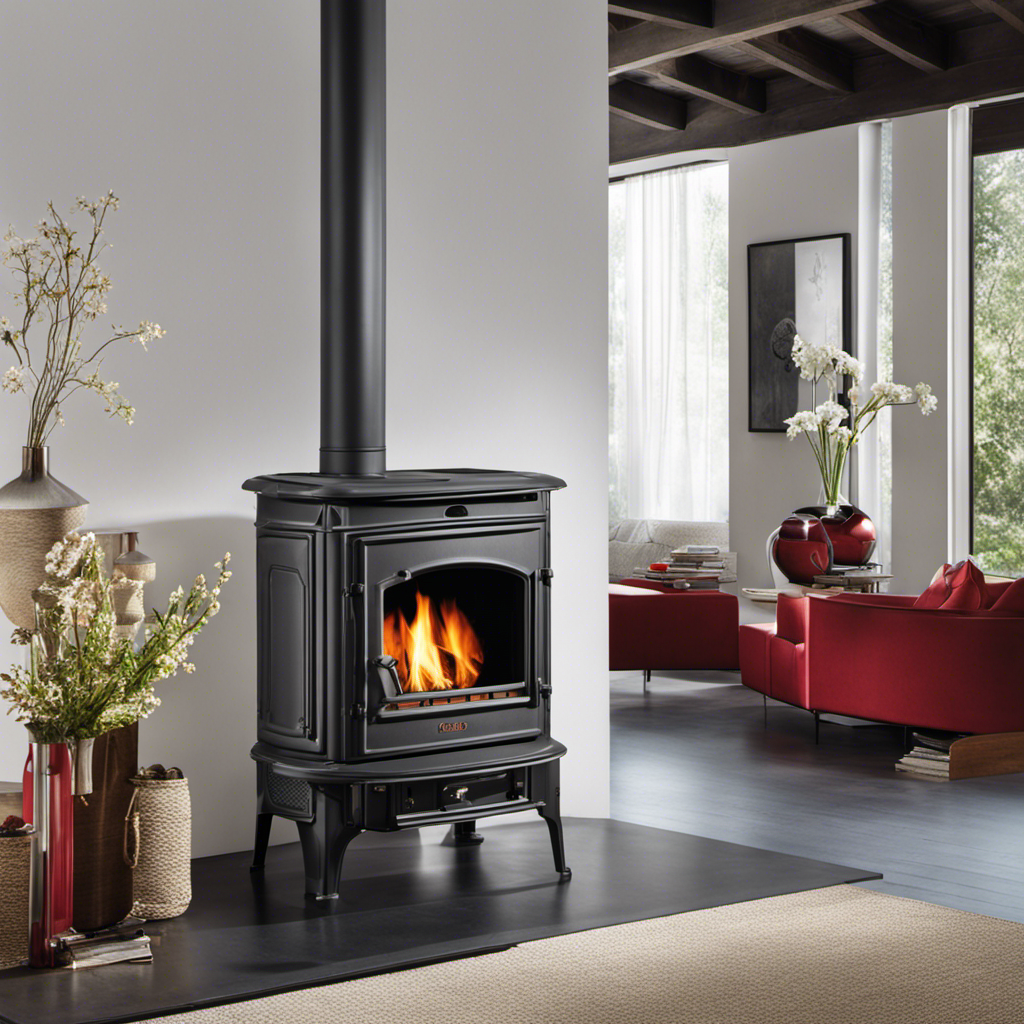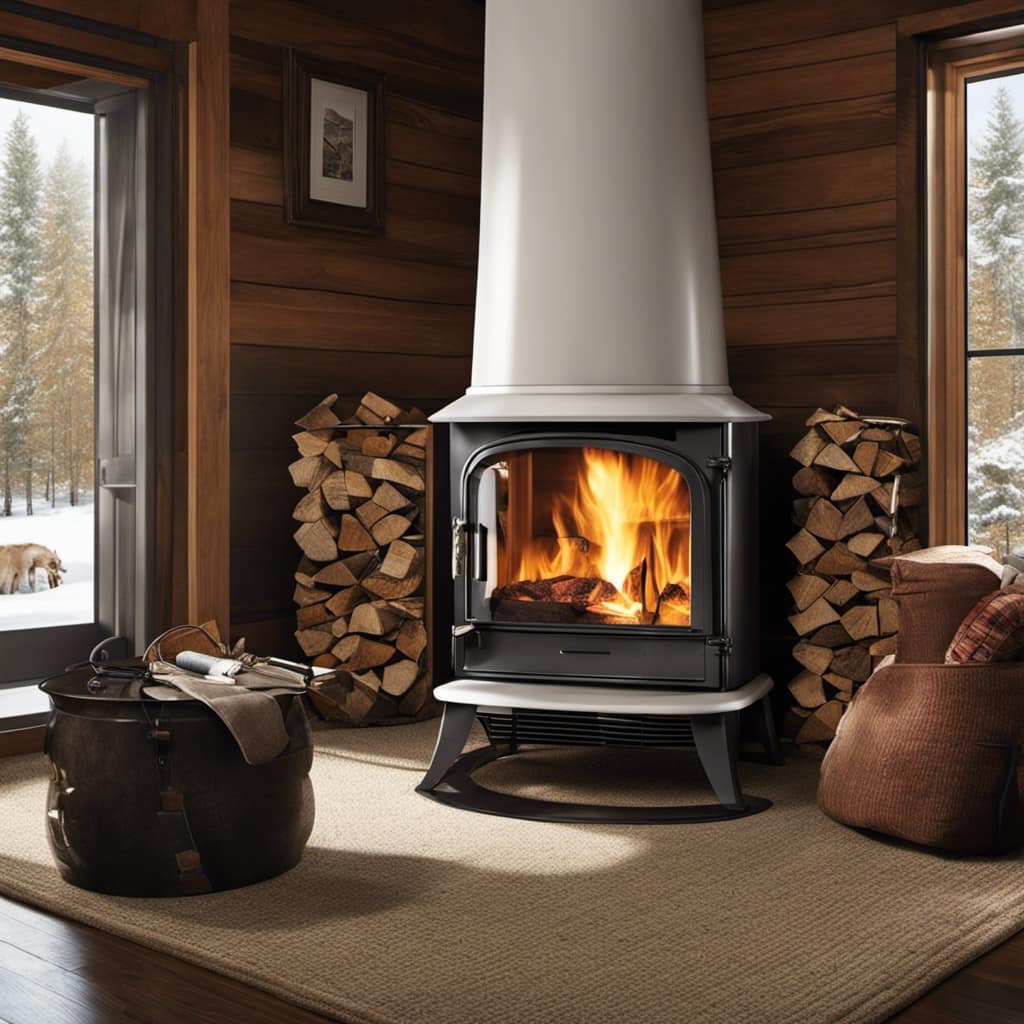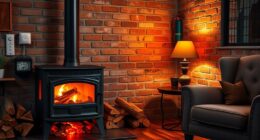As a wood stove enthusiast, I am constantly fascinated by the complexities of achieving maximum burning efficiency.
One crucial component that plays a significant role in enhancing heat output and reducing emissions is the secondary air tube in a Jotul wood stove.
This little tube acts like a secret weapon, injecting a burst of oxygen into the firebox, ensuring a more complete and cleaner burn.
In this article, we’ll dive into the purpose of the secondary air tube and explore its impact on the performance of your Jotul wood stove.
Key Takeaways
- The secondary air tube enhances combustion efficiency in a Jotul wood stove.
- It facilitates secondary air control for optimizing the combustion process.
- The secondary air tube introduces additional air into the combustion chamber, resulting in cleaner and more efficient combustion.
- It plays a significant role in reducing emissions, improving air quality, and increasing heat production in a Jotul wood stove.
The Role of the Secondary Air Tube in Combustion Efficiency
I believe that the secondary air tube significantly enhances the combustion efficiency of the Jotul wood stove.
The secondary air control, which is facilitated by the secondary air tube, plays a crucial role in optimizing the combustion process.
When the stove is in operation, the primary air enters through the primary air inlet and fuels the fire. However, this primary air alone isn’t sufficient for complete combustion.
This is where the secondary air tube comes into play. It introduces additional air into the combustion chamber, allowing for a more thorough burning of the fuel.
This secondary air helps in achieving a cleaner and more efficient combustion, resulting in reduced emissions and increased heat production.
How the Secondary Air Tube Enhances Heat Output
The secondary air tube increases heat output by allowing for better combustion and more efficient burning of the fuel. This small yet crucial component plays a significant role in improving efficiency and maximizing performance in a Jotul wood stove. Here’s how it accomplishes this:
- The secondary air tube introduces additional oxygen into the combustion chamber, promoting more complete combustion of the wood and reducing the production of unburned particles and gases.
- By providing a secondary source of air, the tube creates a more turbulent airflow, ensuring that all areas of the fuel are exposed to oxygen, resulting in a more thorough and efficient burn.
- The secondary air tube also helps to preheat the incoming air, further enhancing the combustion process and increasing heat output.
Understanding the impact of the secondary air tube on emissions is crucial in evaluating the overall environmental impact of a wood stove. Let’s delve into this aspect in the next section.
Understanding the Impact of the Secondary Air Tube on Emissions
Examining the secondary air tube’s influence on emissions reveals the true environmental significance of its role in reducing harmful pollutants.
The secondary air tube in a Jotul wood stove plays a crucial role in improving air quality and reducing the impact on the environment.
By introducing a controlled flow of fresh air into the combustion chamber, the secondary air tube ensures more complete combustion of the wood, resulting in a more efficient and cleaner burn.
This leads to a significant reduction in harmful emissions such as carbon monoxide (CO), nitrogen oxides (NOx), and particulate matter (PM).
The environmental benefits of the secondary air tube are evident in the improved air quality, as it helps to minimize the release of pollutants into the atmosphere.
This not only benefits our health but also contributes to the overall well-being of our planet.
Optimizing the Secondary Air Tube for Clean Burning
To achieve clean burning, it’s essential to frequently monitor and adjust the secondary air tube in order to optimize its performance. The secondary air tube plays a crucial role in improving air circulation within the wood stove, allowing for more efficient combustion and reduced emissions.
By controlling the flow of oxygen into the firebox, it helps to maintain a consistent and controlled burn. This not only ensures that the fuel is burned more completely, but also minimizes the formation of creosote buildup on the interior surfaces of the stove.
Regularly inspecting and adjusting the secondary air tube will help prevent blockages and maintain optimal airflow, resulting in cleaner and more efficient burning. This, in turn, reduces the risk of chimney fires and improves the overall longevity of the stove.
Maintaining and Cleaning the Secondary Air Tube for Longevity
I always make sure to regularly clean and maintain my secondary air tube to ensure its longevity. The secondary air tube plays a crucial role in the efficient functioning of my Jotul wood stove. It helps in the complete combustion of the wood, reducing emissions and increasing the overall efficiency of the stove. Regular maintenance involves checking for any blockages or build-up of soot and ash in the tube. I also troubleshoot any issues that may arise, such as poor draft or excessive smoke. To assist you in understanding the importance of maintaining the secondary air tube, I have prepared a table that highlights the benefits and potential issues that can arise if neglected.
| Benefits of Maintaining | Issues if Neglected |
|---|---|
| Enhanced efficiency | Poor draft |
| Reduced emissions | Excessive smoke |
| Cleaner burn | Incomplete combustion |
Frequently Asked Questions
How Does the Secondary Air Tube Affect the Overall Performance of a Jotul Wood Stove?
The secondary air tube in a Jotul wood stove greatly impacts its performance. It provides additional oxygen to the combustion process, resulting in more efficient and cleaner burning, which leads to better heat production and reduced emissions.
Can the Secondary Air Tube Be Adjusted to Control the Temperature of the Stove?
Adjusting the secondary air tube on a Jotul wood stove can impact the temperature control. By increasing or decreasing the airflow, you can regulate the burn rate and therefore, the heat output of the stove.
What Are the Potential Drawbacks or Disadvantages of Using a Secondary Air Tube?
The potential drawbacks or disadvantages of using a secondary air tube in a Jotul wood stove can include difficulty in adjusting the temperature, increased maintenance requirements, and potential for smoke leaks.
Is It Possible to Retrofit a Jotul Wood Stove With a Secondary Air Tube if It Doesn’t Already Have One?
Yes, it is possible to retrofit a Jotul wood stove with a secondary air tube if it doesn’t already have one. The benefits of adding a secondary air tube include improved combustion efficiency and reduced emissions.
Are There Any Specific Maintenance Tips or Guidelines for Cleaning the Secondary Air Tube?
To keep the secondary air tube in a Jotul wood stove clean, regular maintenance is important. Cleaning tips include using a brush to remove any debris and ensuring proper airflow for efficient burning.
How Do I Remove the Secondary Air Manifold in a Jotul Wood Stove?
To remove the secondary air manifold in a Jotul wood stove, follow these steps. First, ensure the stove is completely cooled down. Then, locate the removing hearthstone tribute wood stove manifold screws or bolts that secure the manifold in place. Using the appropriate tools, carefully loosen and remove these fasteners. Once removed, gently lift and detach the manifold from the stove. Remember to exercise caution while handling the manifold to avoid any damage.
Can the Same Method of Installing Tubes be Used for Jotul Wood Stove as well?
The method used to install tubes on fitting for heatmor may not be suitable for the Jotul wood stove. The process of installing tubes may vary depending on the specific stove model. However, it is important to consult the manufacturer’s guidelines or seek professional assistance to ensure proper installation and optimum performance.
Conclusion
So, there you have it, folks! The secondary air tube in a Jotul wood stove is like the secret sauce that brings combustion efficiency to a whole new level.
It not only boosts heat output but also helps in reducing those nasty emissions.
So, if you want your wood stove to be a clean-burning superstar, don’t forget to optimize and maintain that secondary air tube.
Trust me, your stove will thank you with cozy warmth and eco-friendly vibes!











